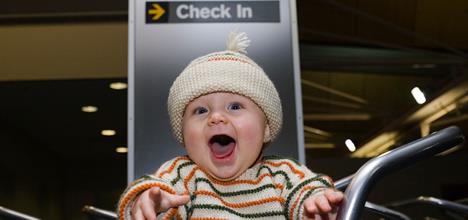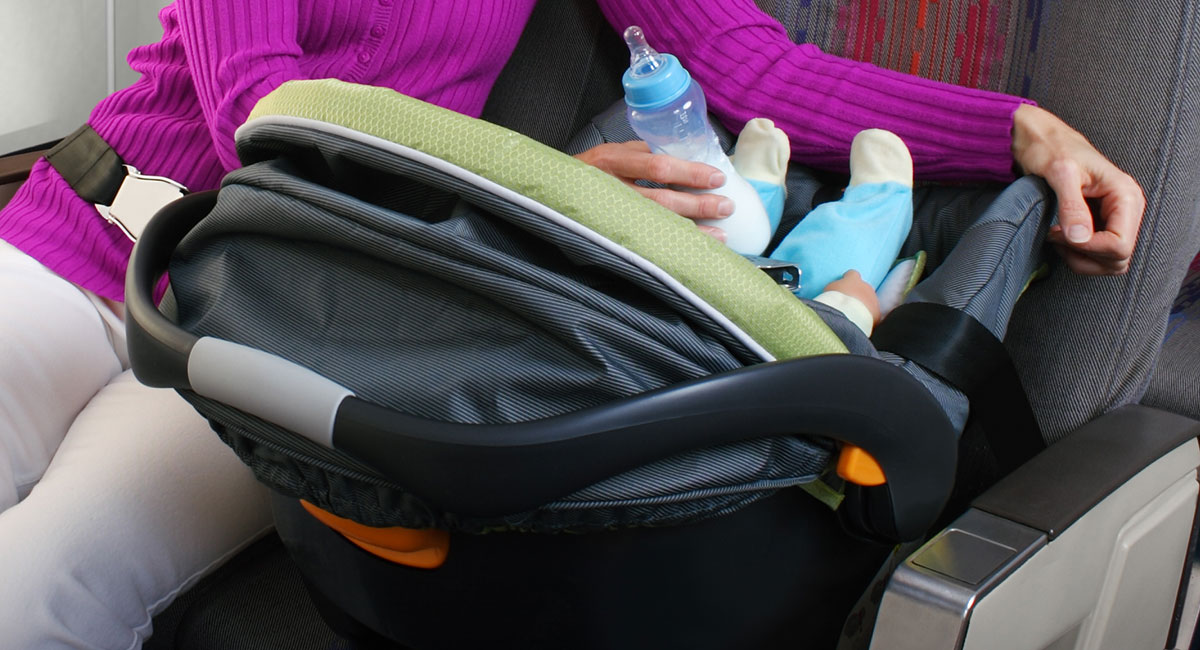
Traveling with a baby on a plane is something that makes most parents nervous and with good reason. Both babies and air travel can be unpredictable, and most of the time it is not a good combination. However, some preparation in advance can help your baby and you and everyone else on the plane have a better experience.
| In this article, the American Academy of Pediatrics (AAP) answers some of the questions you might have before traveling with your baby and offers tips to make your flight easier and safer. |
|---|
Table of Contents
At what age can baby travel on an airplane?
Newborn babies are generally not recommended to fly unnecessarily. Air travel increases the risk of newborns getting infectious diseases. The premature infants with chronic diseases of the heart or lungs, or symptoms of diseases of the upper or lower airways may experience problems due to changes in the oxygen level of the cabin air. Parents should consult with their child’s pediatrician before traveling by plane.
If there is a measles outbreak in your area, or you plan to travel to a place where there is a measles outbreak, your pediatrician may recommend an extra dose of measles, mumps, and rubella (MMR) vaccine for your baby. can be administered from 6 months of age.
Does my baby need a passport to travel outside the country?
Yes. All US citizens, including babies, need a passport to travel out of the country. Parents or guardians must apply for the passport in person with their baby by filling out the DS-11 application (in English). Be sure to bring your baby’s birth certificate and a recent photo taken in the last 6 months. Photos for passports must be taken with no one else in the photo, which is not easy to do with a baby. To do this safely if your baby is not sitting on her own yet, the U.S. Department of State recommends laying your baby on a soft blanket (blanket) to make sure the head is supported without having to hold the baby. Another option is to cover a car seat with a white sheet and take the picture while the baby is sitting in the seat.
And in the case of domestic flights?A valid passport is often the only method of identification your baby needs to travel on a domestic flight, unless you need to verify age to receive a discount on the ticket price. Children under the age of 18 do not need to have a real identification (called Real ID – in English). |
|---|
Should my baby sit on my lap during the flight?
If possible, no. The Federal Aviation Administration (FAA) does not require a ticket to travel for children under 2 years of age, but this implies that your baby must travel on your lap (legs). If there is turbulence or worse, you may have a hard time protecting the baby in your arms. If you don’t buy a ticket for your child, ask the airline you’re traveling to to allow you to use an empty seat. If airline policy allows you to do so, avoid traveling on busy days and hours so you have a better chance of finding an empty seat next to yours
The safest way for your baby to travel:The AAP recommends that the safest way for your baby to travel in an airplane is a car seat, one for use in automobiles approved by the FAA or one that has an airplane harness designed for the age and size of the child installed with the aircraft seat belt. Booster seats should not be used on airplanes. |
|---|
Should I bring the car seat on the plane? Does it count as baggage?
 Car safety seats, booster seats, and strollers generally do not count as luggage, but airline policies vary; check with your airline before you travel. In most cases they can be checked in at the exit gate, where there is less risk of damage and at no cost. If your baby has an assigned individual seat, bring your car seat.
Car safety seats, booster seats, and strollers generally do not count as luggage, but airline policies vary; check with your airline before you travel. In most cases they can be checked in at the exit gate, where there is less risk of damage and at no cost. If your baby has an assigned individual seat, bring your car seat.
Not all car safety seats are approved for use in aircraft.Make sure your car seat brand indicates: ” This seat is certified for use in motor vehicles and on airplanes .” |
|---|
Which airplane seat is best for the baby?
- Try to find the row of the plane that has the most space, such as bulkhead or partition wall seats. Seats with emergency exits should not be used for safety reasons.
- Choose a seat near the window, if possible. Aisle seats can be dangerous for babies during beverage service. Hot beverages passed to passengers can spill and cause burns, and babies’ arms and legs can get caught or trapped in service carts. Aisle seats are also at risk of items or luggage falling out of superior behaviors.
Is there a possibility that my baby can lie down on long flights?
Buckling your baby into your car seat or child restraint is the safest option. However, there are also other options to help your baby sleep comfortably, especially on extremely long trips.
- Moses or airline cradle . Some airlines have cribs or bassinets available for bulkhead seats, behind the galley / galley or bathroom or another cabin. In some exclusive cabs, they can be assembled in the seat compartment for use in bulkhead seats. Most airline cribs are for babies under 6 months and under 20 pounds (9 kg) and who cannot sit on their own yet. These cribs or bassinets are also called baskets, beds, baskets or baskets. Check with your airline when making reservations.
- Bed seats . For an additional cost, some international airlines allow you to reserve three seats in a row with locking to extend the seats, thus creating an “sky or air sofa” or a sleeping seat large enough for the adult and the child. “
- Inflatable seat extensions . Sometimes airlines allow you to bring your own inflatable product, individual seat extension so that your baby can sleep in them lying down. These are fairly recent products, and not all airlines allow their use, so find out in advance. Your child will need a seat of her own to use.
Note: For all of the above options, your baby must be buckled into a car seat or supported on your legs (lap) during takeoff, turbulence, and landing
Safe sleep practices should be applied on airplanes.
|
|---|
Will I be able to pass liquid formula or expressed breast milk through the security booth?
Yes, but you have to follow the rules for carrying reasonable amounts. This means that you are exempt from the 3-1-1 rule that does not allow liquids over 3.4 oz. in a quart (1 liter) bag and one bag per passenger.
Pack formula, expressed breast milk, or water to mix the powder separately and be prepared to tell the TSA agent what you are carrying. You can ask them not to put them through the x-ray machine (although this should not cause health problems). Visit the TSA website for more information.
Any other recommendations for my baby to travel comfortably and happily on the plane?
- Dress it in layers. The temperature on an airplane can vary a lot, especially if you have to wait a long time on the runway, so dressing in layers is a good idea. When choosing clothes, select clothes that can facilitate diapering in a small space. Also, pack a change of clothes or two, in case there is turbulence when you are changing the diaper or when you are feeding. Bring plastic bags for dirty clothes.
- Prepare to deal with an earache. During ascent, after takeoff, and during descent before landing, pressure changes can cause discomfort in the outer and middle ear. If your baby has had ear surgery or an ear infection in the two weeks before the flight, ask your doctor if you can fly. Putting the baby to breastfeed or drink milk from a bottle or suck on a pacifier (pacifier) can help. If your child has a cold or ear infection, a dose of acetaminophen or ibuprofen can help, check with your doctor to find out how much to give your child.
- Remember that it is best for everyone when the baby sleeps. If possible, try to travel during the hours your baby normally sleeps, or consider skipping a nap until it is time to fly. Flight delays can ruin your plan and your baby may decide to scream instead of sleep. But it is worth a try.
Do not use diphenhydramine or Benedryl to make it easier for your baby to fall asleep without checking with your doctor.
|
|---|
- Try to change diapers just before boarding. A dry baby is a happy baby. Fortunately, when you have to change a baby’s diaper in flight, many planes have changing tables in their bathrooms. If the plane you are traveling on doesn’t have one, ask the flight attendant if there is any place on the floor where you can put your diaper changing table. Some parents resort to changing the diaper on top of the closed toilet seat. If you do try, be sure to support your baby with one hand at all times and have a disposable changing table available. Plan for delays, and pack extra supplies.
- Bring things to distract. Pack some toys and books, and be ready to play with your baby all the time. A video tablet can be a good reinforcement if toys or books become uninteresting to you (we don’t recommend using media devices to distract children under 2, but desperate situations call for desperate measures).
- Don’t let disapproving (hateful) looks make you feel bad. Despite all your efforts to be prepared, babies sometimes cry. You did everything you could and continue to do the best you can. When this happens, one of the best things you can do to calm your baby is to stay calm. And remember that for every person who looks at you disapprovingly, there are many more who have been through what you are going through and will express solidarity with you.
- Ask for help. Make arrangements with your airline to help you if you need to connect to another flight. Carrying a car seat, your baby and luggage through a busy airport is not easy.

Leave a Reply